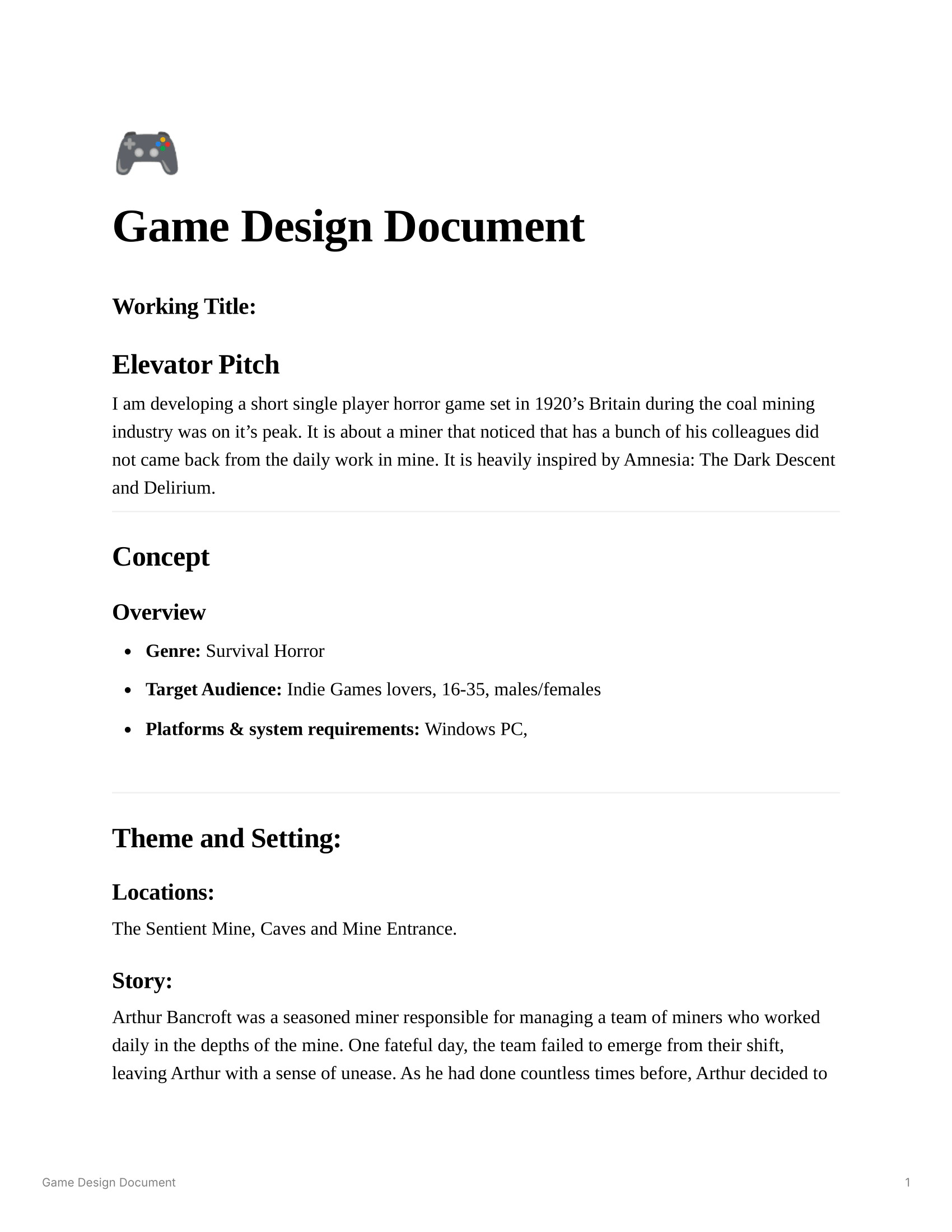Creation of “Tiny Canary”
Before kicking off my Minor Skilled, I was doing some market research for my internship. What caught my eye was the growing demand for designers who know their way around Unreal Engine. Since my university education mostly focused on Unity, I decided to dedicate six months of Minor to learning this new engine and creating a game solo.
Throughout my education, I mainly took on roles like Narrative Designer and didn't get much hands-on experience with the engine. So, I decided to delve into the whole pipeline myself, figuring out a method and order that would work for me, and ultimately, create a little passion project.
The initial concept for the game revolves around a single-player horror experience set in 1920s Britain, at the peak of the coal mining industry. Our protagonist, a miner, notices some colleagues didn't make it back from their daily work in the mine. Motivated to investigate, he rushes to check on them. When he arrives, he's met with piercing screams that lead him deeper into the mine. However, the pathways have shifted, trapping him with limited equipment and only his canary as a means to escape the toxic gas.
I created a Game Design Document, that demonstrates the original idea for the project.
In the initial phase, I kicked things off by laying down the structure for the Game Design Document (GDD). Crafting a comprehensive and detailed version of this document was paramount for my approach. Within it, I outlined the core idea, the mechanics I envisioned, and the control scheme (Nuclino, n.d). My reference points were the professional Game Design Documents of renowned titles like Silent Hill, Grand Theft Auto, Bioshock, and Fallout 2. Naturally, mine was a more concise version, less intricate in terms of graphics.
The subsequent step in my process involved mapping out the game's level layout. I aimed to establish distinct zones within the level, encompassing an introduction area, a tense moment, a safe space, and two levels offering player choices. Drawing from my insights into horror theory, I acknowledged the significance of varying the mood to instill a sense of terror in the player. A continuous onslaught of intense experiences could lead to fatigue and diminish the impact of subsequent suspenseful moments.
Entering the Develop phase, I initiated by prototyping walking and jumping mechanics using Blueprints in Unreal Engine. Refining the prototype by downsizing the game environment by 2 (Figure 5), I set the stage for playtesting and feedback gathering to enhance mechanics and overall gameplay.
Main mechanics, including the Gas system divided into gas zones and canary detection, were implemented. Troubleshooting with engineer friends ensured flexibility through adjustable blueprint values. Initially planning two enemy types, feedback led to a strategic decision to focus on a singular enemy type, preserving the significance of the gas system.
Creating an Enemy AI script posed a complex challenge. The enemy, scanning its surroundings, initiated pursuit upon detecting the player, resulting in immediate consequences for encounters. Though encountering hurdles in code compilation and debugging, dedication to refining Enemy AI for a polished gaming experience persisted.
The first playtesting round revealed favorable responses but indicated concerns about enemy speed. Striving for a balanced gameplay experience, adjustments were made to ensure challenges were engaging yet manageable.
Facing challenges in VRAM allocation during environment setup, expert guidance and adjustments improved frame rate by 40 frames. Meticulously finalizing the environment, attention shifted to creating 3D models. Autodesk Maya was utilized for the unique Canary model, with texturing performed directly in Unreal Engine.
Creating Pickaxe 3D models replaced placeholders, enhancing visual fidelity. Time constraints led to the decision to source an online 3D model for the Enemy, rigged and animated using Mixamo to streamline development.
Sound design, implemented using FL Studio, enriched the game's atmosphere. A four-minute looped ambience track, coupled with carefully curated ambient sounds and growling effects, contributed to the immersive experience.
In the course of this project, I've accomplished approximately 80% of the planned tasks and objectives. While some elements like the narrative and UI/UX design weren't implemented, this deliberate choice stemmed from my proficiency and experience in those areas from prior projects. I aimed to challenge myself by focusing on areas where I felt less confident, further enhancing my skills.
Prototyping: Rapidly creating functional prototypes has proven vital for testing and refining game mechanics, establishing a robust foundation for the final product.
Blockout Creation: Early creation of blockout models aided in defining spatial layout and overall structure, providing a visual guide for subsequent development.
Asset Implementation: Proficiency in integrating 3D models, textures, and assets within the game engine brought the game world to life, enhancing player immersion.
Troubleshooting: Addressing technical issues and bugs honed my troubleshooting skills, ensuring efficient problem identification and resolution for smooth game functionality.
Optimization: Implementing optimization techniques improved the game's performance, ensuring smooth operation on various hardware configurations.
Lighting: Applying lighting techniques to create mood, atmosphere, and visual appeal contributed significantly to my skill development, enhancing the project's visual quality.
Sound Design: Incorporating sound elements like ambient sounds, music, and character effects played a crucial role in immersing players and elevating their overall experience.
Soft Skills Development:
Time Management: Efficiently managing time and setting realistic deadlines for each project stage was crucial in ensuring timely task completion.
Hour Logging: Maintaining detailed records of hours spent on each project aspect provided a clear overview of progress, identifying areas needing more attention or time.
Resource Estimates: Estimating required resources, such as time, budget, and manpower, facilitated efficient planning and resource allocation for a smooth project flow.
Communication: Regular communication with team members, mentors, and professionals facilitated idea exchange, feedback, and insights, contributing to overall project improvement.
Prioritization: Learning to prioritize tasks based on importance and impact on project success helped focus on critical aspects first.













